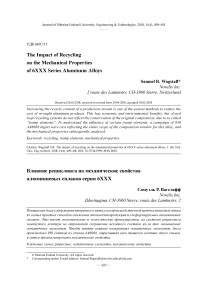The impact of recycling on the mechanical properties of 6XXX series aluminum alloys
Автор: Wagstaff Samuel R.
Журнал: Журнал Сибирского федерального университета. Серия: Техника и технологии @technologies-sfu
Статья в выпуске: 4 т.11, 2018 года.
Бесплатный доступ
Increasing the recycle content of a production stream is one of the easiest methods to reduce the cost of wrought aluminum products. This has economic and environmental benefits, but closed loop recycling systems do not reflect the conservation of the original composition, due to so called “tramp elements”. To understand the influence of certain tramp elements, a campaign of 950 AA6008 ingots were cast reflecting the entire scope of the composition window for this alloy, and the mechanical properties subsequently analyzed.
Recycling, tramp elements, mechanical properties
Короткий адрес: https://sciup.org/146279369
IDR: 146279369 | DOI: 10.17516/1999-494X-0063
Список литературы The impact of recycling on the mechanical properties of 6XXX series aluminum alloys
- Green J.A.S. Aluminum recycling and processing for energy conservation and sustainability. Materials Park, OH: ASM International, 2007.
- Liu Z-K. Effect of impurities on alloys. I.T. Program. Washington, DC: Energy Efficiency and Renewable Energy, US Department of Energy, 2003.
- Gesing A. Journal of Materials. 2004, 56, 18-27.
- Kim J-Y., Kim S-J., Song I-K., Han J-H. Aging characteristics of recycled ACSR wires for distribution lines. Electrical insulation conference and electrical manufacturing & coil winding conference, 1997.
- Viklund-White C. and Menad N. Impurity accumulation as a consequence of increased scrap recycling. Stockholm, Sweden: Minerals and Metals Recycling Research Centre, MiMeR Lulea University of Technology, 1999, pp. 35.
- Lundqvist U., Andersson B., Axsater M., Forsberg P., Heikkila K. and Jonson U. et al. Design for recycling in the transport sector -future scenarios and challenges. Goteborg, Sweden: Chalmers University of Technology, Goteberg University, 2004.
- Das S.K. Light Metals, TMS, 2006, 911-916.
- Gesing A. and Harbeck H. Particle sorting of light-metal alloys and expanded use of manufacturing scrap in automotive, marine, and aerospace markets. In: Global symposium on recycling, waste treatment, and clean technology (REWAS), 2008.
- Gaustad G., Olivetti E., Kirchain R. Journal of Industrial Ecology, 2010, 14, 286-308.
- Phillip H.W.L. Annotated equilibrium diagrams of some aluminium alloy systems. London, Institute of Metals, 1959.
- Mondolfo L.F. Aluminium alloys: structure and properties. London: Boston, Butterworths, 1976.
- Kral M.V. A crystallographic identification of intermetallic phases in Al-Si alloys. Materials Letters, 2005, 59, 2271-2276.
- Phillips H.W.L. and Varley P.S. The constitution of alloys of aluminium with manganese, silicon and iron. III -The ternary system: aluminium-silicon-iron. IV -The quaternary system: aluminiummanganese-silicon-iron. Journal of the Institute of Metals, 1943, 69, 317-350.
- Phragmén G. On the phases occurring in alloys of aluminium with copper, magnesium, manganese, iron and silicon. Journal of the Institute of Metals, 1950, 77, 489-552.
- Couture A. Iron in aluminium casting alloys -a literature survey, American Foundryman’s Society. International Cast Metals Journal, 1981, 6 (4), 9-17.
- Crepeau P.N. Effect of iron in Al-Si alloys: a critical review. Transactions of the American Foundryman’s Society, 1995, 103, 361-366.
- Taylor J.A. Metal-related castability effects in aluminium foundry alloys. Cast Metals, 1995, 8 (4), 225-252.
- Mbuya T.O et al. Influence of iron on castability and properties of aluminium silicon alloys: literature review. International Journal of Cast Metals Research, 2003, 16 (5), 451-465.


